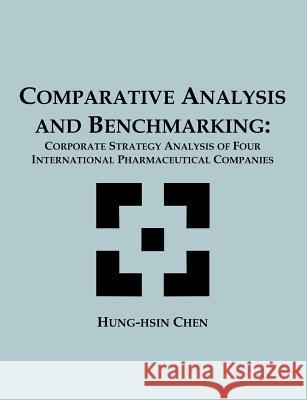Comparative Analysis and Benchmarking: Corporate Strategy Analysis of Four International Pharmaceutical Companies » książka
Comparative Analysis and Benchmarking: Corporate Strategy Analysis of Four International Pharmaceutical Companies
ISBN-13: 9781581121896 / Angielski / Miękka / 2003 / 140 str.
Comparative Analysis and Benchmarking: Corporate Strategy Analysis of Four International Pharmaceutical Companies
ISBN-13: 9781581121896 / Angielski / Miękka / 2003 / 140 str.
(netto: 96,05 VAT: 5%)
Najniższa cena z 30 dni: 100,58
ok. 16-18 dni roboczych
Dostawa w 2026 r.
Darmowa dostawa!
This research of corporate strategy analysis implements comparative analysis and benchmarking to analyse and examine the corporate strategy of the pharmaceutical sectors of 4 international pharmaceutical companies. This research adopts the hybrid approach of combining qualitative and quantitative methods in a two stages research design. Quantitative method is applied first to deal with the comparative figures, and then qualitative method is used to find out the problem. The design of this multiple research includes three phases: data collection, analysis, and reporting. The findings of this research can be divided into 4 parts: R&D/marketing, technology alliances, strategic acquisitions and merger, and manufacturing. The drug innovative projects are recommended being developed within the company's familiar therapeutic areas in order to take its marketing advantage. Through this comparative analysis, some of this type of problems of these international pharmaceutical companies is identified. A big pharmaceutical company forming alliances with some small biotechnology companies has become a trend within pharmaceutical industry since 1980s. For pharmaceutical companies, to take advantage of R&D through biotechnology is the main purpose of alliances with small biotechnology companies. It is important to note that most pharmaceutical acquisitions belong to the type of absorption with high resource transferring and low autonomy. Due to the high profit margin and the essential importance of R&D and marketing, the operation management of manufacturing of pharmaceutical industry is relatively poor. The low asset utilisation rate pointed out this problem. Academic researches have revealed that existing theories of operation management of manufacturing, such as action research, set-up reduction, teamwork, continuous improvement, collaboration, and involvement, are applicable and beneficial to pharmaceutical industry rather than waiting for the technology breakthroughs.
This research of corporate strategy analysis implements comparative analysis and benchmarking to analyse and examine the corporate strategy of the pharmaceutical sectors of 4 international pharmaceutical companies. This research adopts the hybrid approach of combining qualitative and quantitative methods in a two stages research design. Quantitative method is applied first to deal with the comparative figures, and then qualitative method is used to find out the problem. The design of this multiple research includes three phases: data collection, analysis, and reporting. The findings of this research can be divided into 4 parts: R&D/marketing, technology alliances, strategic acquisitions and merger, and manufacturing. The drug innovative projects are recommended being developed within the companys familiar therapeutic areas in order to take its marketing advantage. Through this comparative analysis, some of this type of problems of these international pharmaceutical companies is identified. A big pharmaceutical company forming alliances with some small biotechnology companies has become a trend within pharmaceutical industry since 1980s. For pharmaceutical companies, to take advantage of R&D through biotechnology is the main purpose of alliances with small biotechnology companies. It is important to note that most pharmaceutical acquisitions belong to the type of absorption with high resource transferring and low autonomy. Due to the high profit margin and the essential importance of R&D and marketing, the operation management of manufacturing of pharmaceutical industry is relatively poor. The low asset utilisation rate pointed out this problem. Academic researches have revealed that existing theories of operation management of manufacturing, such as action research, set-up reduction, teamwork, continuous improvement, collaboration, and involvement, are applicable and beneficial to pharmaceutical industry rather than waiting for the technology breakthroughs.











